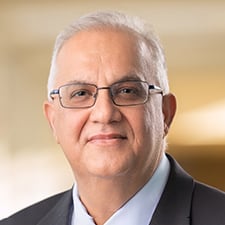Atlantic Health System in New Jersey uses augmented intelligence (AI) to spot potential abnormalities in diagnostic imaging studies and then move those images to the top of the list for a radiologist to review.
This effort, called the Radiology Imaging Artificial Intelligence Analysis Project, was recently recognized as an example of “enterprise excellence” by CIO, a publication that covers the “digital transformation” of businesses.
“With this tool, AI takes on a variety of tasks, many of which were manual and repetitive in nature, to assist with getting the radiologist critical information as quickly as possible,” notes the publication, which named Atlantic Health to its CIO 100 list that recognizes organizations for “innovative use of technology, creating competitive advantage in their organizations, improving business processes, enabling growth and improving relationships with customers.”
Jose Rios, MD, PhD, the radiology informatics medical director for Atlantic Medical Group and the Atlantic Health System—a member of the AMA Health System Program—spoke with the AMA to explain how the AI project works.
“If there are emergent findings on a study, it will alert us to them so that we can expedite the care for these critical findings—things like intracranial hemorrhages or pulmonary emboli,” Dr. Rios said. “So, things that might have sat on our work list to be read within the next day or so we are now looking at them within minutes of them being done, because the software is there to help us do our jobs and do it efficiently and provide better patient care.”
Dr. Rios added that this expediting of care is where he finds AI to be the most helpful.
“AI's role is to help augment our abilities and help us prioritize,” he said. “It is also helping me be more efficient at what I do, and that's where its value to me lies.”
Using AI and its decision-support tools also works to relieve stress that comes with worrying that something important was missed—which leads to “doing that one neurotic last check again,” Dr. Rios said, adding that this is particularly true for the residents who train with him.
“It definitely helps ease burnout—especially for people like our trainees, who don't have the years of experience an attending does,” he said. “I always preach to them to treat AI like a safety net, not as a crutch, and that they need to make their own interpretation first—and then look at what the AI is trying to point out.”
Learn about artificial intelligence versus augmented intelligence and the AMA’s research and advocacy in this vital and emerging area of medical innovation.
Avoiding shiny toy syndrome
According to Sunil Dadlani, senior vice president and chief information officer for Atlantic Health, this radiology AI project is just one part of the health system’s ambitions to drive the next generation of care to improve patient outcomes.
“We are innovating across the broad spectrum,” Dadlani said.
“That means disease detection, disease diagnostics, disease triaging, defining care plans, admission, discharge, transfers and remote care patient monitoring,” he added. “And we do not limit AI to only the clinical side. We are leveraging AI and innovating on operational side, financial side, supply-chain side and marketing side.”
Dr. Rios said he was also thankful for the work that Dadlani and his team does, which involves listening to physicians’ concerns and then acting on them. One example: limiting the number of steps needed to use the technology.
“I'm sure a lot of physicians out there can attest—one of the reasons for burning out is the number of clicks that we have to get through to just sign a chart,” he said.
Dadlani said Atlantic Health works to stay away from “shiny toy syndrome,” in which technology is added without a specific purpose. Instead, technology is used to solve a defined problem—such as finding gaps in care—without adding complexity or the clerical burdens that can drive burnout.
A key is “human-centric design,” which includes giving physicians or other clinical staff—and not the AI algorithm—the “final yea or nay” on a decision.
“Technology, if done correctly, can be a competitive advantage,” Dadlani said. “If not done correctly, it can really bring down the organization to its knees.”




